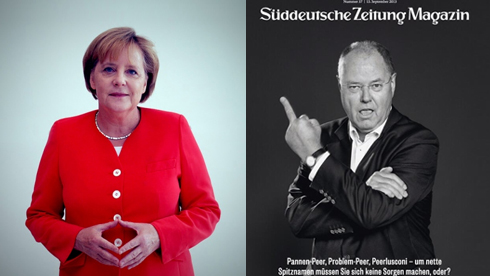Now he's got a trademark. One that quickly stands out, that works without words, that everyone knows. Whether Peer Steinbrück did himself a favour with his “stink-finger” (middle finger) pose remains to be seen. One thing he did achieve, though: very close to the federal election day, is to become the number-one talked-about topic, complete with a magazine cover that has split the Republic.
For a long time now Angela Merkel has been associated with a special gesture: a peculiar knotting of her fingers while standing. The "Merkel diamond" was once ridiculed, but her election campaign strategists are now splashing it on huge billboards and hooded sweaters to get across the image they’re after: Merkel the Sound, the Straightforward, the Reliable.
In comparison, Steinbrück’s stink-finger is pure confrontation. The photo was taken a few weeks ago, but the candidate for the Chancellery knew that it would be coming out now. His finger is therefore to be understood as a statement: with it, he cements the distinction between himself and the controlled, demure Chancellor. And he makes it clearer than ever how differently the rivals present themselves in the final dash to the federal election.
1. What’s behind the diamond and the middle finger
Lately the Chancellor has been using her diamond only rarely. The gesture itself became a fixture long ago, without regular exposure. Merkel plays down the importance of how she holds her hands: "It has a certain symmetry," she once said. When blown up on a facade to the scale of a tennis court, though, her hands do not seem quite so symmetrical.
Steinbrück’s middle-finger motif is not suitable for billboard exposure. It ought to provide the one-time bang! effect, which will reverberate for a while. The photo has raised a fundamental debate about how smoothly politicians should be ironed out and just where the border is crossed into bad taste. For some, the pose is an act of liberation; for others, it breaks a taboo.
That half of Germany is debating a middle finger or that pranksters have nothing better to do than to tinker on parodies of the "Merkel diamond" on the Internet could cause some head-shaking. But the power of images should not be underestimated. When topics and positions are being bandied about in duels and public arenas, symbolism enters the game. [[For undecided voters, how they vote on September 22 will come down to a gut feeling. Gestures are remembered. Complex lines of argument over the pension issue are not]].
2. How Steinbrück and Merkel want to come across
In the final phase of the election campaign, the SPD is relying on a poster in the style of Obama, with a smiling Steinbrück in a sea of humanity waving red flags. On Facebook, his team is posting tons of close-up photos of the candidate for Chancellor. There’s Steinbrück with a kebab skewer, Steinbrück with a fluttering dove of peace, Steinbrück with a sun hat out for a walk. On the website of the SPD, he poses, blissfully smiling, in a group of women.
The CDU is banking it all on their leading lady, who very rarely strays from her role. A snapshot from the election campaign, published by a regional newspaper on the Internet, shows the Chancellor in a mischievous boxing pose. Such frivolity is the exception, though: the Chancellor is playing it safe.
Plain-speaking against the “consensus Chancellor” is the strategy the SPD is pursuing. When Merkel says, "Some wages are simply not right", Steinbrück says, “As Chancellor I will immediately introduce a statutory minimum wage of €8.50."
Tranquility up against thundering fulmination: "The right thing is not always what is demanded the most loudly," says the Chancellor in the election advertisement of the CDU. Steinbrück’s strategists have fished out a sentence from a spring interview and dropped it back into the campaign: "I say what I think, and I do what I say."
4. Conclusion: Both have a problem putting themselves across
Merkel isn’t putting anyone off with her We-must-look-into-the-details formulae. In the aesthetics of her election campaign, she hugs the comfort zone, never taking a risk. This total control can be difficult, though, to keep up all the way. If her opinion is asked, for example on gay marriage, she stumbles – live and visible to everyone.
The numerous I-will-do-this-and-I will-do-that claims by Steinbrück come across as excessive. Even if he could pull off an election win, a government is not a solo event. The "stink-finger" pose also shows that Steinbrück cannot decide who he wants to be. He has built up some sympathy recently, on posters, at lecterns, in front of the cameras, and the aggro-stare and his middle finger do not fit into this charm offensive at all. Many voters will likely be left perplexed.
Was this article useful? If so we are delighted!
It is freely available because we believe that the right to free and independent information is essential for democracy. But this right is not guaranteed forever, and independence comes at a cost. We need your support in order to continue publishing independent, multilingual news for all Europeans.
Discover our subscription offers and their exclusive benefits and become a member of our community now!












